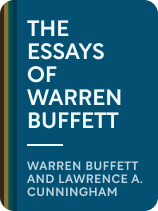

This article is an excerpt from the Shortform book guide to "The Essays of Warren Buffett" by Warren Buffett and Lawrence A. Cunningham. Shortform has the world's best summaries and analyses of books you should be reading.
Like this article? Sign up for a free trial here.
What is Warren Buffett’s investment philosophy? What is the best piece of advice you can take on board from the world’s most successful investor?
The key philosophy that Buffett drives home is that owning a stock means owning a piece of an actual, real-world business. Using this “owner mindset” as a starting point, Buffett provides guidance to reasonable expectations, best practices in investing, and certain pitfalls to avoid when investing.
Keep reading to learn about Warren Buffett’s philosophy and best practices for investing.
Warren Buffett: How to Invest
For casual and professional investors alike, the most salient insight from Warren Buffett’s philosophy is to think of a stock as a piece of an actual, real-world business. With this in mind, Buffett recommends you identify and invest in a solid, well-run business at a time when that business’s stock is offered at a discount to its overall value. Buffett’s strategy is conceptually simple, though it entails a lot of work for investors to learn how to properly value businesses in order to know if the price is high or low. Once you buy into a good business, Buffett recommends holding on to its stock indefinitely so long as the business remains well-managed and provides a steady return on capital. Because the value of a stock is directly linked to the fortunes of the business itself, in the long run, stocks can’t provide higher returns on investment than the businesses they represent can turn capital into profit.
(Shortform note: In the classic text A Random Walk Down Wall Street, economist Burton G. Malkiel gives a more detailed description of how to calculate a stock’s long-term returns, which are based on a combination of dividends (the portion of a company’s profits paid directly to shareholders) and the company’s projected growth in earnings over time. Malkiel says that short-term investors must also factor in the ratio of a stock’s share price to the company’s earnings, which varies dramatically from year to year. Like Buffett, Malkiel suggests that to generate overall positive returns, it’s best to hold on to stocks for a long time.)
This goes against Wall Street’s common narrative, in which stock prices and businesses’ value have little to do with each other. In general, the market trends upward over time, but Buffett is clear that the market is driven by investors’ collective emotional mood swings. Those swings sometimes offer great buys at good prices, but otherwise you should ignore the random moods of the market. Some short-term traders may use swings in the market to make a quick buck, but most of them will fail. Meanwhile, trading itself causes a financial drain in the form of fees to investment banks and brokers. Buffett endorses long-term financial commitments in which you can make the most of your dollar.
(Shortform note: Short-term traders bet on their ability to accurately forecast the future. In Superforecasting, journalist Dan Gardner and psychologist Philip Tetlock argue that there are people who can do this, but they’re rare. Good forecasters know how to avoid cognitive bias, consider more than one perspective, and think in terms of future probabilities. All of these are traits that could easily describe Buffett, but he studiously avoids making forecasts of the future. In The Snowball, Buffett’s biographer Alice Schroeder says the one prediction Buffett did make was that tech stocks in the ’90s would prove a poor investment. He was right.)
Best Practices
Though Buffett’s essays mainly explain how he makes investment decisions on behalf of Berkshire Hathaway shareholders, he shares a great deal of advice that applies to individual investors as well. Principal among these are that you should invest in industries you understand, recognize the value of market volatility, and put your money in simple index funds to benefit from the market’s general upward momentum.
Buffett drives home the business ownership aspect of buying stock and suggests that you use any industry knowledge you have to your advantage. For example, if your work overlaps with the publishing industry, then you know which companies are the industry leaders and which have the best future prospects. If the top two or three are publicly traded and their stock doesn’t seem overpriced, put a significant amount of money into those businesses. (Shortform note: A publicly traded company is one whose stock is for sale on open stock exchanges and not held by a handful of private investors.)
You are now an owner of a piece of a business that you understand well. If the company’s stock shoots up after you buy it, don’t consider that a signal to sell. Rather, look forward to your long-term gains as an owner rather than the short-term gains you may receive from trading.
(Shortform note: Acting on general knowledge about an industry or public information about a company is distinct from illegal insider trading, in which someone misuses nonpublic information to profit from a trade in a public company’s stock. Because people very close to the workings of a business, such as its CEO and directors, always have access to non-public information, the US Securities and Exchange Commission (SEC) has strict rules about reporting any trades executives make of their own companies’ stock, rules that are continually amended to close loopholes.)
Buffett says that in the short run, stock prices aren’t a good measure of a business’s true value. Instead, what matters is whether a company makes effective use of capital to produce good returns in the form of steady profits. For this reason, avoid industries in which you lack knowledge and where future prospects are hard to predict. Buffett favors companies whose products can weather any market downturn—items that people will always need to buy regardless of economic ups and downs, such as food, clothing, insurance, and utilities.
(Shortform note: Buffett practices what author Jim Collins calls “hedgehog thinking.” According to Collins in his book Good to Great, hedgehog thinkers are those who don’t spread their expertise thin, but instead focus on the one thing they do best and with the most passion. For Buffett, that passion is analyzing businesses to determine their true value. For those who aren’t financial experts, that focus might be the industry you work in or a trend you follow closely. In Poor Charlie’s Almanack, Buffett’s business partner Charles Munger defines this as your “circle of competence,” which determines the areas within which you can make good decisions.)

———End of Preview———
Like what you just read? Read the rest of the world's best book summary and analysis of Warren Buffett and Lawrence A. Cunningham's "The Essays of Warren Buffett" at Shortform.
Here's what you'll find in our full The Essays of Warren Buffett summary:
- A glimpse into the mind of a man who disagrees with the typical Wall Street mogul
- Buffett's simple yet difficult insights on investing
- Why some of the most widely accepted economic practices are wrong






